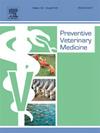印度古吉拉特邦活禽店(LBSs)基于风险的框架:确定病原体进入和暴露风险概况
IF 2.4
2区 农林科学
Q1 VETERINARY SCIENCES
引用次数: 0
摘要
活禽店(LBSs)和市场(LBMs)是亚洲常见的鸡肉交易场所。公共卫生研究通常探讨东南亚的lbm,强调它们在传染病流行病学中的相关性。然而,LBSs在病原体传播中的作用仍未得到充分研究,特别是在肉鸡和土鸡(德什)普遍存在的印度。在印度古吉拉特邦进行的这项研究描述了LBSs的做法,并评估了其病原体进入和暴露于鸡和人的可能性。从2020年12月至2021年3月,在8个主要部落和非部落城市的86个lbs收集了标准化问卷调查和实地观察结果。风险评估框架确定了三种病原体风险途径:LBS病原体进入、鸡暴露和人类暴露。多变量分析评估了每条风险路径下LBSs的风险概况,并在适用的情况下区分了鸡的类型。研究结果显示,根据每种风险途径和所售鸡肉的不同类型,有三种LBS集群被划分为低风险或高风险。lbs的区域是集群组成的重要决定因素。高风险的支点通常位于非部落城市,与其他支点相比,他们从更远的地方和更多的供应商那里获得鸡肉供应。每个城市的群集分布相对均匀,在部落地区很明显,这表明有机会采取有针对性的干预措施,以减轻病原体的传播。鸡暴露的高风险群与肉鸡LBSs的自由漫游饲养条件和德氏LBSs的高剩余比例有关。个人防护装备使用不足、卫生标准差以及没有将屠宰区与销售区分开,导致了人类暴露风险。在所有群集中都观察到未售出的家禽与新供应的家禽混合,并将活禽饲养过夜,这可能促进家禽病原体的传播和持续存在。该研究确定了具有独特管理和地理特征的LBS风险集群,强调了定制疾病控制策略的必要性。提出的基于风险的框架为在类似的家禽贸易环境中进行有针对性的干预提供了一个有价值的工具。本文章由计算机程序翻译,如有差异,请以英文原文为准。
A risk-based framework for live bird shops (LBSs) in Gujarat, India: Identifying pathogen entry and exposure risk profiles
Live bird shops (LBSs) and markets (LBMs) are frequent venues for chicken trading in Asia. Public-health research commonly explores LBMs across Southeast Asia, emphasizing their relevance in infectious disease epidemiology. However, LBSs’ role in pathogen transmission remains understudied, particularly in India, where broiler and indigenous chickens (deshi) are common. This study, conducted in Gujarat, India, described LBSs practices and assessed their potential for pathogen entry and exposure to chickens and humans. Standardized questionnaires and field observations were collected at 86 LBSs across eight major tribal and non-tribal cities, from December 2020 to March 2021. A risk-assessment framework identified three pathogen risk-pathways: LBS pathogen entry, chicken exposure and human exposure. Multivariate analyses assessed LBSs’ risk profiles for each risk-pathway, distinguishing between chicken types where applicable. The findings revealed three LBS clusters categorized as lower- or higher-risk for each risk-pathway and respective chicken type sold. LBSs’ region was a strong determinant of cluster composition. Higher-risk LBSs were typically located in non-tribal cities and received chicken supplies from farther away and more suppliers compared to other LBSs. The relatively uniform distribution of clusters per city, noticeable in tribal regions, suggests an opportunity for targeted interventions to mitigate pathogen transmission. Higher-risk clusters for chicken exposure were linked to free-roaming rearing conditions for broiler LBSs and a high proportion of surplus for deshi LBSs. Human exposure risks were driven by inadequate individual-protective-equipment use, poor hygiene standards and failure to separate slaughtering from sales areas. Mixing of unsold poultry with newly supplied birds and keeping live birds overnight were observed across all clusters, potentially facilitating spread and persistence of poultry pathogens. This study identified LBS risk-clusters with distinct management and geographical characteristics, highlighting the need for tailored disease control strategies. The presented risk-based framework offers a valuable tool for targeted interventions in similar poultry trade settings.
求助全文
通过发布文献求助,成功后即可免费获取论文全文。
去求助
来源期刊

Preventive veterinary medicine
农林科学-兽医学
CiteScore
5.60
自引率
7.70%
发文量
184
审稿时长
3 months
期刊介绍:
Preventive Veterinary Medicine is one of the leading international resources for scientific reports on animal health programs and preventive veterinary medicine. The journal follows the guidelines for standardizing and strengthening the reporting of biomedical research which are available from the CONSORT, MOOSE, PRISMA, REFLECT, STARD, and STROBE statements. The journal focuses on:
Epidemiology of health events relevant to domestic and wild animals;
Economic impacts of epidemic and endemic animal and zoonotic diseases;
Latest methods and approaches in veterinary epidemiology;
Disease and infection control or eradication measures;
The "One Health" concept and the relationships between veterinary medicine, human health, animal-production systems, and the environment;
Development of new techniques in surveillance systems and diagnosis;
Evaluation and control of diseases in animal populations.
 求助内容:
求助内容: 应助结果提醒方式:
应助结果提醒方式:


